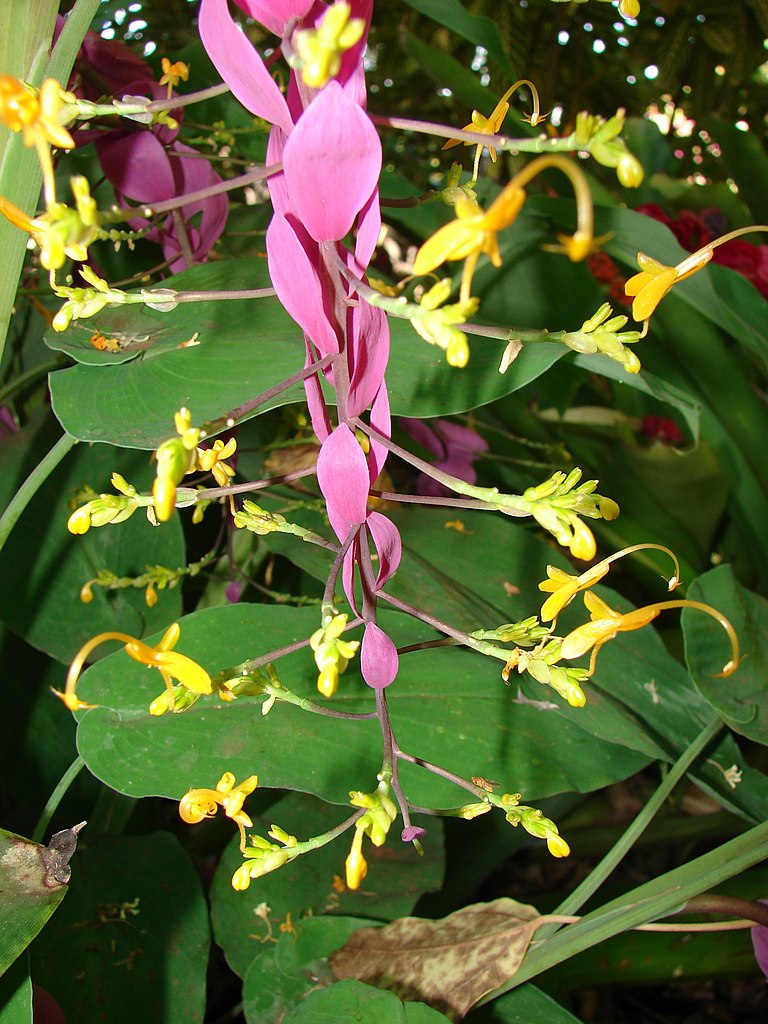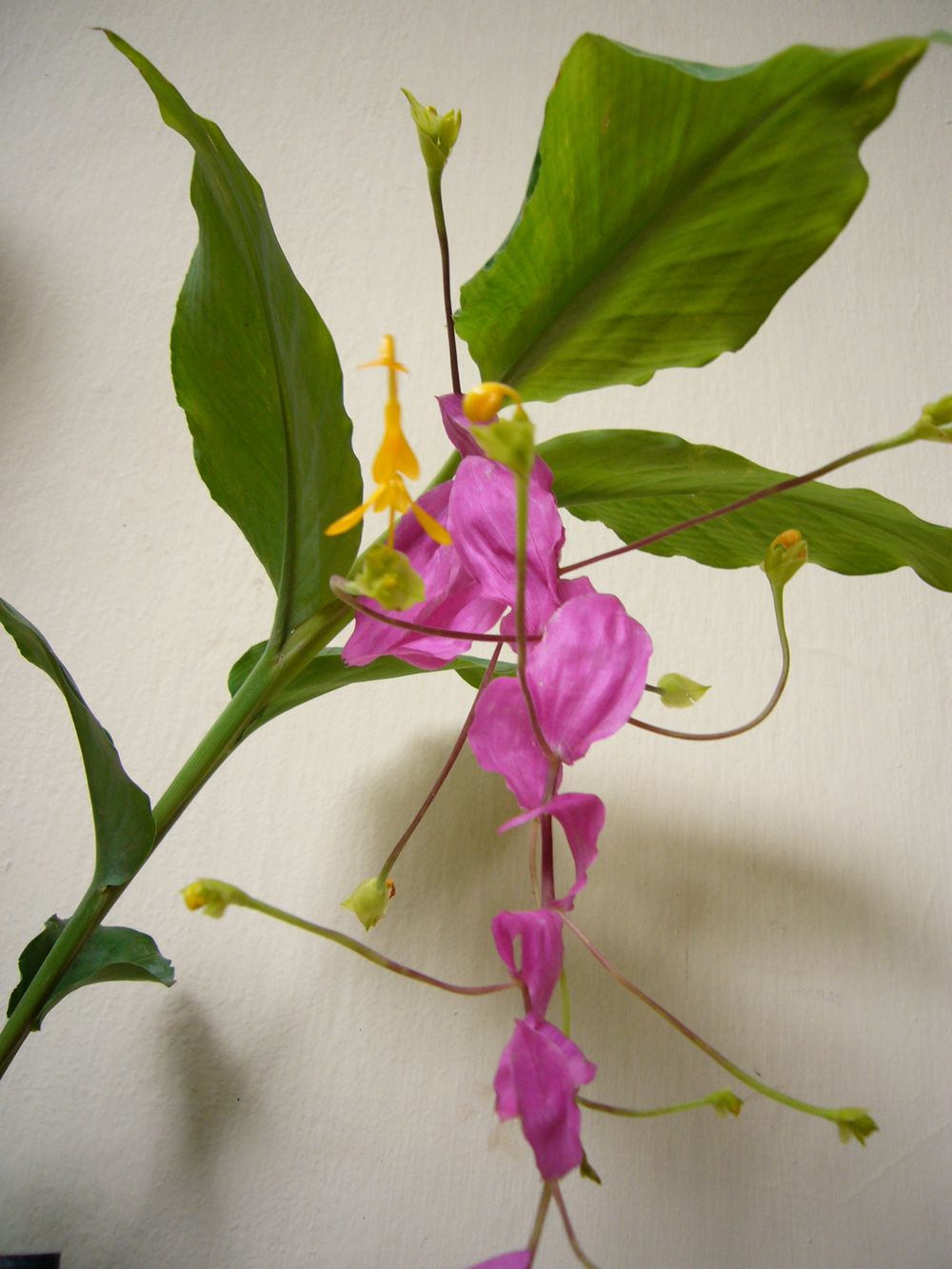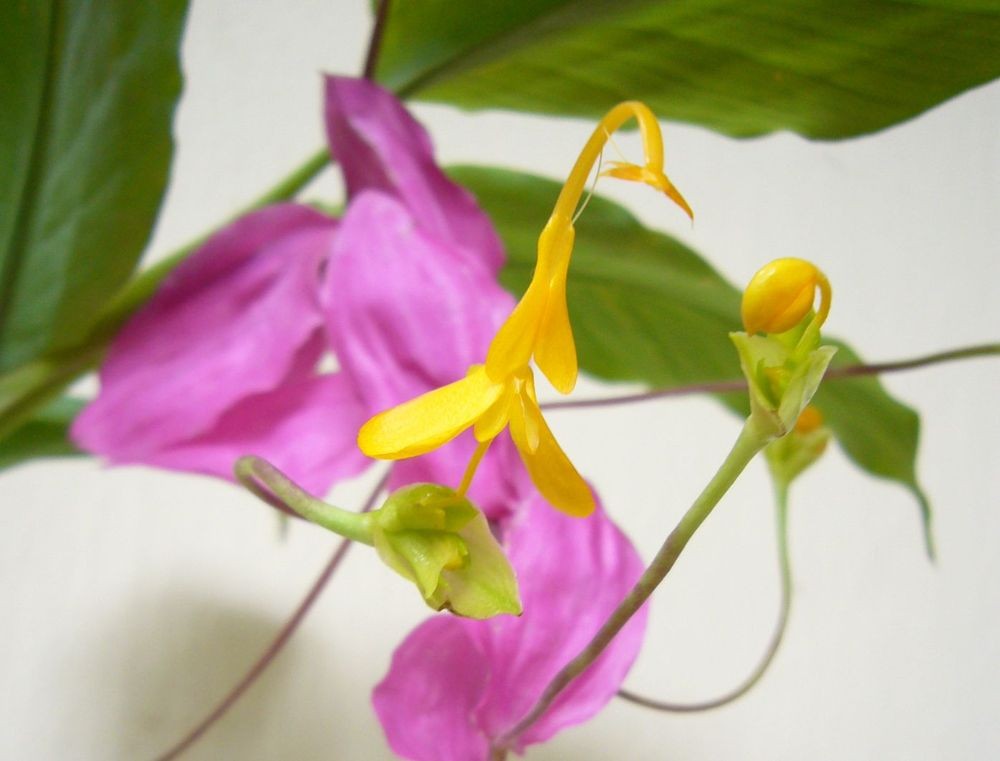Another plant whose Laotian name is not yet fixed, though it is native to the region, particularly Thailand. We are discussing it because it is truly beautiful and deserves to be known.
It is a perennial with rhizomes, shorter than ginger, with alternate, lanceolate leaves that are heart-shaped at the base. The flower consists of a vibrant pink bract, from which emerges a long tube in purple or yellow, ending with yellow petals. The overall effect is stunning, colorful, and light; one of its English names is Red Dancing Girl. The fruit is a capsule that bursts open, dispersing seeds that ants are fond of. This beautiful wild ginger has naturally captured the interest of horticulturists who have created cultivars, adding to the numerous species in the region. Indeed, the Indochinese Peninsula is rich in Zingiberaceae, far from being fully explored. Botanists regularly discover new plants, sometimes leading to a complete reclassification; the taxonomy of the family can be described as quite ambiguous, with numerous synonyms and significant gaps. Currently, it comprises fifty-three genera (one thousand five hundred species), with fifty originating from Southeast Asia.
In general, these rhizomatous plants often possess medicinal properties, being tonic or refreshing. The challenge lies in determining the species when examining roots at markets, whether they are sold as vegetables or medicinal herbs, as only a part of the plant is available. Sellers refer to them as van nam or van pa, meaning “water rhizome” and “forest rhizome”; van nam likely corresponds to a genus like Globba. The significance in medicine and magic of plants named van is well-known; they are prescribed for various ailments.
While waiting to learn more through the work of botanists, one can admire these mysterious plants that bring forth such strange flowers from the earth.
Encore une plante dont le nom lao n’est pas fixé et pourtant elle est originaire de la région, en tous les cas de Thaïlande. Si nous en parlons c’est qu’elle est vraiment très jolie et mérite d’être connue.
C’est une vivace à rhizome, moins haute que le gingembre, avec des feuilles alternes, lancéolées, en forme de cœur à la base. La fleur est composée d’une bractée rose vif d’où s’échappe un long tube pourpre ou jaune, terminé par des pétales jaunes. L’ensemble est du plus bel effet, très coloré et léger, d’ailleurs l’un de ses noms anglais est Red Dancing Girl, « la fille rouge qui dance ». Le fruit est une capsule qui éclate en dispersant des graines dont les fourmis sont friandes. Ce beau gingembre sauvage a bien entendu intéressé les horticulteurs qui en ont fait des cultivars qui viennent s’ajouter aux nombreuses espèces qui existent dans la région. En effet la péninsule indochinoise est riche de Zingibéracées qui sont loin d’avoir été complétement explorées. Régulièrement les botanistes découvrent de nouvelles plantes et ces découvertes conduisent parfois à remanier toute la classification; on peut dire que la taxonomie de la famille est des plus floues, qu’elle comporte de nombreux synonymes et en même temps des lacunes importantes. Elle compte à l’heure actuelle cinquante-trois genres (mille cinq cents espèces), dont cinquante sont originaires d’Asie du Sud Est.
En général toutes ces plantes à rhizome ont des propriétés médicinales, elles sont souvent toniques ou rafraîchissantes. Le problème est que, lorsque l’on examine ces racines chez les marchands, qu’ils soient d’ailleurs de légumes ou de médicaments, on ne peut en déterminer l’espèce n’ayant qu’une partie de la plante. Les vendeurs les nomment van nam ou van pa c’est-à-dire « rhizome d’eau », « rhizome de forêt »; le van nam doit correspondre à un Globba. On sait l’importance en médecine et magie des plantes nommées « van » qui sont prescrites pour toutes sortes de maux.
En attendant d’en savoir plus grâce au travail des botanistes, on peut admirer ces plantes mystérieuses qui font jaillir de la terre des fleurs si étranges.



Another plant whose Laotian name is not yet fixed, though it is native to the region, particularly Thailand. We are discussing it because it is truly beautiful and deserves to be known.
It is a perennial with rhizomes, shorter than ginger, with alternate, lanceolate leaves that are heart-shaped at the base. The flower consists of a vibrant pink bract, from which emerges a long tube in purple or yellow, ending with yellow petals. The overall effect is stunning, colorful, and light; one of its English names is Red Dancing Girl. The fruit is a capsule that bursts open, dispersing seeds that ants are fond of. This beautiful wild ginger has naturally captured the interest of horticulturists who have created cultivars, adding to the numerous species in the region. Indeed, the Indochinese Peninsula is rich in Zingiberaceae, far from being fully explored. Botanists regularly discover new plants, sometimes leading to a complete reclassification; the taxonomy of the family can be described as quite ambiguous, with numerous synonyms and significant gaps. Currently, it comprises fifty-three genera (one thousand five hundred species), with fifty originating from Southeast Asia.
In general, these rhizomatous plants often possess medicinal properties, being tonic or refreshing. The challenge lies in determining the species when examining roots at markets, whether they are sold as vegetables or medicinal herbs, as only a part of the plant is available. Sellers refer to them as van nam or van pa, meaning “water rhizome” and “forest rhizome”; van nam likely corresponds to a genus like Globba. The significance in medicine and magic of plants named van is well-known; they are prescribed for various ailments.
While waiting to learn more through the work of botanists, one can admire these mysterious plants that bring forth such strange flowers from the earth.
Encore une plante dont le nom lao n’est pas fixé et pourtant elle est originaire de la région, en tous les cas de Thaïlande. Si nous en parlons c’est qu’elle est vraiment très jolie et mérite d’être connue.
C’est une vivace à rhizome, moins haute que le gingembre, avec des feuilles alternes, lancéolées, en forme de cœur à la base. La fleur est composée d’une bractée rose vif d’où s’échappe un long tube pourpre ou jaune, terminé par des pétales jaunes. L’ensemble est du plus bel effet, très coloré et léger, d’ailleurs l’un de ses noms anglais est Red Dancing Girl, « la fille rouge qui dance ». Le fruit est une capsule qui éclate en dispersant des graines dont les fourmis sont friandes. Ce beau gingembre sauvage a bien entendu intéressé les horticulteurs qui en ont fait des cultivars qui viennent s’ajouter aux nombreuses espèces qui existent dans la région. En effet la péninsule indochinoise est riche de Zingibéracées qui sont loin d’avoir été complétement explorées. Régulièrement les botanistes découvrent de nouvelles plantes et ces découvertes conduisent parfois à remanier toute la classification; on peut dire que la taxonomie de la famille est des plus floues, qu’elle comporte de nombreux synonymes et en même temps des lacunes importantes. Elle compte à l’heure actuelle cinquante-trois genres (mille cinq cents espèces), dont cinquante sont originaires d’Asie du Sud Est.
En général toutes ces plantes à rhizome ont des propriétés médicinales, elles sont souvent toniques ou rafraîchissantes. Le problème est que, lorsque l’on examine ces racines chez les marchands, qu’ils soient d’ailleurs de légumes ou de médicaments, on ne peut en déterminer l’espèce n’ayant qu’une partie de la plante. Les vendeurs les nomment van nam ou van pa c’est-à-dire « rhizome d’eau », « rhizome de forêt »; le van nam doit correspondre à un Globba. On sait l’importance en médecine et magie des plantes nommées « van » qui sont prescrites pour toutes sortes de maux.
En attendant d’en savoir plus grâce au travail des botanistes, on peut admirer ces plantes mystérieuses qui font jaillir de la terre des fleurs si étranges.






Another plant whose Laotian name is not yet fixed, though it is native to the region, particularly Thailand. We are discussing it because it is truly beautiful and deserves to be known.
It is a perennial with rhizomes, shorter than ginger, with alternate, lanceolate leaves that are heart-shaped at the base. The flower consists of a vibrant pink bract, from which emerges a long tube in purple or yellow, ending with yellow petals. The overall effect is stunning, colorful, and light; one of its English names is Red Dancing Girl. The fruit is a capsule that bursts open, dispersing seeds that ants are fond of. This beautiful wild ginger has naturally captured the interest of horticulturists who have created cultivars, adding to the numerous species in the region. Indeed, the Indochinese Peninsula is rich in Zingiberaceae, far from being fully explored. Botanists regularly discover new plants, sometimes leading to a complete reclassification; the taxonomy of the family can be described as quite ambiguous, with numerous synonyms and significant gaps. Currently, it comprises fifty-three genera (one thousand five hundred species), with fifty originating from Southeast Asia.
In general, these rhizomatous plants often possess medicinal properties, being tonic or refreshing. The challenge lies in determining the species when examining roots at markets, whether they are sold as vegetables or medicinal herbs, as only a part of the plant is available. Sellers refer to them as van nam or van pa, meaning “water rhizome” and “forest rhizome”; van nam likely corresponds to a genus like Globba. The significance in medicine and magic of plants named van is well-known; they are prescribed for various ailments.
While waiting to learn more through the work of botanists, one can admire these mysterious plants that bring forth such strange flowers from the earth.
Encore une plante dont le nom lao n’est pas fixé et pourtant elle est originaire de la région, en tous les cas de Thaïlande. Si nous en parlons c’est qu’elle est vraiment très jolie et mérite d’être connue.
C’est une vivace à rhizome, moins haute que le gingembre, avec des feuilles alternes, lancéolées, en forme de cœur à la base. La fleur est composée d’une bractée rose vif d’où s’échappe un long tube pourpre ou jaune, terminé par des pétales jaunes. L’ensemble est du plus bel effet, très coloré et léger, d’ailleurs l’un de ses noms anglais est Red Dancing Girl, « la fille rouge qui dance ». Le fruit est une capsule qui éclate en dispersant des graines dont les fourmis sont friandes. Ce beau gingembre sauvage a bien entendu intéressé les horticulteurs qui en ont fait des cultivars qui viennent s’ajouter aux nombreuses espèces qui existent dans la région. En effet la péninsule indochinoise est riche de Zingibéracées qui sont loin d’avoir été complétement explorées. Régulièrement les botanistes découvrent de nouvelles plantes et ces découvertes conduisent parfois à remanier toute la classification; on peut dire que la taxonomie de la famille est des plus floues, qu’elle comporte de nombreux synonymes et en même temps des lacunes importantes. Elle compte à l’heure actuelle cinquante-trois genres (mille cinq cents espèces), dont cinquante sont originaires d’Asie du Sud Est.
En général toutes ces plantes à rhizome ont des propriétés médicinales, elles sont souvent toniques ou rafraîchissantes. Le problème est que, lorsque l’on examine ces racines chez les marchands, qu’ils soient d’ailleurs de légumes ou de médicaments, on ne peut en déterminer l’espèce n’ayant qu’une partie de la plante. Les vendeurs les nomment van nam ou van pa c’est-à-dire « rhizome d’eau », « rhizome de forêt »; le van nam doit correspondre à un Globba. On sait l’importance en médecine et magie des plantes nommées « van » qui sont prescrites pour toutes sortes de maux.
En attendant d’en savoir plus grâce au travail des botanistes, on peut admirer ces plantes mystérieuses qui font jaillir de la terre des fleurs si étranges.


